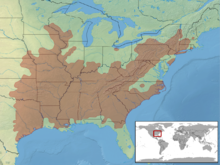Forest rattlesnake
| Forest rattlesnake | ||||||||||||
|---|---|---|---|---|---|---|---|---|---|---|---|---|

Forest rattlesnake ( Crotalus horridus ) |
||||||||||||
| Systematics | ||||||||||||
|
||||||||||||
| Scientific name | ||||||||||||
| Crotalus horridus | ||||||||||||
| Linnaeus , 1758 |
The forest rattlesnake ( Crotalus horridus ) is a species of rattlesnake ( Crotalus ), whose range extends over much of the eastern and southeastern United States of America .
features
The forest rattlesnake is a large and strongly built rattlesnake with an average body length of about 1 meter, but in individual cases it can be up to 1.80 meters long. In its body color, the species varies relatively strongly, the basic color being gray to yellowish and becoming darker towards the rear. The drawing pattern consists of black and regular rhombuses (diamonds) or cross bands. The two subspecies also differ in the drawing pattern; while C. h. horridus is speckled with small black dots, C. h. atricaudatus has an orange to cinnamon-colored stripe on the back, which also extends over the transverse straps.
distribution and habitat
The habitat of the forest rattlesnake extends over much of the eastern and southeastern United States of America from the Great Lakes in the north to northern Florida (the species is absent on the peninsula itself) and southern Texas . In Canada it is also found in a small part of Ontario .
food
The forest rattlesnake mostly feeds on mice, rats, rabbits, squirrels and occasionally birds.
Reproduction
The Crotalus horridus is sexually mature at around three to four years. The forest rattlesnake, like all other rattlesnakes, is a live-bearing snake. The mating season begins shortly after the hibernation. After a gestation period of around four to five months, the female gives birth to between five and fifteen young, depending on age. They measure around 30 to 35 centimeters after birth.
Life expectancy
The life expectancy of the forest rattlesnake is around 25 to 30 years.
Snake venom
The venom of this snake is essentially the same as that of the diamond rattlesnake and is considered to be slightly less effective. Above all, it leads to local tissue destruction and pain, which is followed by general nausea . If left untreated, the bite can be fatal, with reports of this being very rare.
Systematics
There are currently two subspecies of the forest rattlesnake:
- C. h. atricaudatus which occupies a wide coastal belt from Virginia to Texas in the southern part of the range
- C. h. horridus in the northeast to northern part of the range as far as Canada.
literature
- Chris Mattison: Rattlers! - A natural history of rattlesnakes. Blandford, London 1996, ISBN 0-7137-2534-6 , p. 110.
Web links
- Crotalus horridus in The Reptile Database
- Crotalus horridus inthe IUCN 2013 Red List of Threatened Species . Listed by: Hammerson, GA, 2007. Retrieved September 9, 2013.

